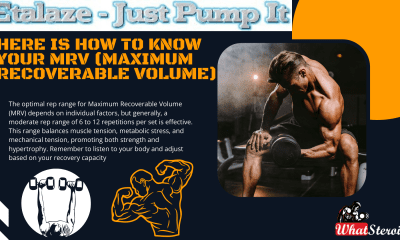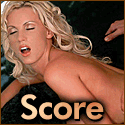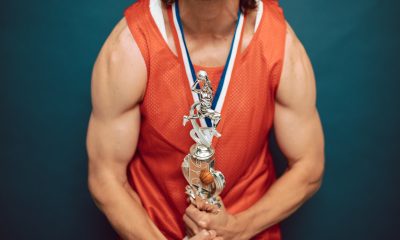Bodybuilding
Which Muscle Groups Should be Trained First?

Which muscle groups should a bodybuilder train first? This question concern many people coming to the gym, but it affects them differently. Someone is only interested in his biceps and nothing more. Another is interested in introducing exercises for the legs and back in his program. The third one asks himself if this is so important. And there are many other opinions on this question. At least every bodybuilder tends to have his idea.
But is there a recipe that effectively solves the problem of what to train first? After all, since bodybuilding claims to be a scientific sport, it has to answer the question.
From the outset, it is essential to determine what the term “being trained firstly” means and if this is a long-term or short-term process.
Understanding Muscle Groups In The Human Body?
The human body is composed of various muscles, each with its unique role in the body. Muscles are responsible for movement, posture, and balance. To understand how the body works and moves, it is essential to know the different types of muscles in our bodies.
We will discuss the different types of muscles in the human body and their roles. It will also provide examples of how these muscles are used in everyday life.
There are two types of muscles in the human body: skeletal and smooth. Skeletal muscles comprise the skeletal system responsible for movement, posture, and balance. Smooth muscles are found throughout the body including in organs, and account for bodily functions such as digestion, regulating blood pressure, and controlling pH levels.
If we are talking about long-term plans for the correction of muscle, then it would be selected throughout the training program the most important and topical areas. For someone, a paramount task becomes the corrective training of the shoulder, girdle, or pectoral muscles, while others may focus their attention on hands or feet.
Must Read: Your Blueprint For Building Bigger Shoulders
Amateur Vs. Pro Bodybuilding
Moving in this direction, it is necessary from the beginning to understand that amateur bodybuilding is used to correct obvious flaws and shortcomings rastrenirovan body, whatever gender you are, male or female.
And for this little to choose the vector of future work, it is equally important - to make this choice promptly and without delay. This will depend on tangible progress for young athletes; doping is the strongest in the world.
Signs of emerging strains of muscles, especially in areas that recently caused resentment from the owner, can bring pleasure to the mind of any visitor to the gym. For this obvious reason, it -is very important to define the priority muscle groups, even starting a program to develop the first level.
Now you'll know that is the most important thing for you compared with other things. Remember that everything flows, and everything changes, so sooner or later, it will have to conduct their*-++9 audit again. Order of exercises during the training and the week.
Must Read: Bodybuilding Training Principles
Order of Exercises for Muscle Groups in the Gym
Regarding the order of exercises for individual training, it is essential to follow the challenge. At the beginning of training, the reserves of muscle power are highest, and, therefore, they have to be used for training lagging muscle groups.
You will have to do it even then when it would go counter to the desire to pump today's favorite muscle rather than those that need attention. One should not focus mainly on developed muscles just because they are generally easier and more enjoyable to train.
You have to know that later it would be more difficult to fix the problem with less developed muscles. For example, given the lack of development of pectoral or calf muscles, you need first to work out in training these muscle groups, and after this, the other ones, moving according to plan.
According to the same rule should be structured a split week system; that is, after the very long rest, first need to load the problematic muscles exactly as long as they do not cease to be in such a place and do not take others for attention gaps muscles.
Commitment to the principles of basic training. At the same time, we wonder what kind of muscle to training firstly and secondly; we can not exclude such an important aspect of gaining mass training as hardcore training. That basic training is based on the fulfillment of heavy squats, bench presses, and rods, leading to a long-awaited set of primary and functional muscles.
Training Individual Muscles In Order
Training each muscle in the gym is essential for achieving the desired fitness goals. Working on individual muscles helps to build strength and endurance while also helping to prevent injury.
Understanding which muscles are involved in each exercise and how they should be trained for maximum benefit is essential. Understanding this makes it possible to create a practical workout routine that targets all necessary muscles for optimal results.
The Chest Muscles
The chest is a large muscle that is involved in multiple exercises. Many people think of the chest as the primary muscle group for an upper body workout, but it should not be trained to fail regularly. It helps to gain strength and endurance by performing compound lifts, such as squats.
The pecs are also targeted when performing pressing exercises such as bench presses and push-ups. The deltoids help lift the shoulders, allowing for a more excellent range of motion when performing other movements, such as pull-ups or rows.
Back Muscles
The muscles that help stabilize the spine are essential for preventing injuries. They provide support and stability while providing a strong foundation for other muscles to work.
Strengthening the spine will help with back pain and other related issues. You can strengthen these muscles through weight training, core exercise, or exercises that use your body weight or resistance bands.
Stomach Muscles
The muscles of the abdominals are vital for stabilizing the pelvis and abdominal region. They help prevent back pain, maintain proper spine alignment, and are vital in other movements, such as push-ups.
The muscles that control breathing allow for efficient oxygen intake and removal from the body, reducing the likelihood of hyperventilation.
Strength Training for Various Muscle Groups
Working out in the gym is an effective way of improving your overall health and fitness. When training different muscles in the gym, it is crucial to understand the importance of targeting specific muscle groups. This will help you focus on strengthening and toning specific areas of your body more effectively.
You can improve your strength, endurance, flexibility, and balance by training different muscles in the gym. Bodybuilders can also reduce their risk for injury by strengthening weak areas of their bodies that are prone to injury. You can get the most out of each workout session with proper technique and form while avoiding potential injuries or strains.
An important part of fitness is strength training. Strength is the ability to exert force and control your body weight during movement, achieved through resistance training.
Strength can be developed through various activities, including lifting weights, using resistance bands, doing yoga and Pilates movements, and running on a treadmill or track.
A well-rounded fitness program should include strength training twice a week and cardiovascular activity such as running, swimming, or cycling three times a week for 45-60 minutes each session.
Reducing Muscle Groups Weakness
The reasons behind muscle weakness vary but usually come down to physical or a general lack of exercise or movement. As your muscles weaken, they also become more prone to injury, making it harder to perform basic movements such as twisting and turning.
It is more difficult to balance, walk, run and perform other tasks that require a stable core.
Working out can be a great way to build strength and muscle mass, but your progress may be limited if you don't take the proper steps to reduce muscle weakness. Bodybuilders need to take proactive measures to reduce muscle weakness and fatigue to maximize their gains.
We will discuss how bodybuilders can reduce muscle weakness and improve their overall performance in the gym. Some techniques, such as proper warm-up routines, stretching exercises, rest days, and nutrition, can help bodybuilders reduce muscle fatigue and optimize their workouts.
Know Your Muscle
Understanding the muscles used during basic compound movements such as bicep curls and deadlifts is key to reducing muscle weakness.
When people first start lifting, their focus is usually on building strength with larger muscle groups, but after a few months of training, they realize that some small muscles they have never used before need to be strengthened.
These smaller muscles will help you support bigger lifts better without sacrificing carrying out your reps. Beginners need to ensure these smaller stabilizing muscles are healthy and strong to support their bigger muscles when working out. The body then becomes stronger and more stable, which leads to better performance.
Overall
For this reason, the entire training process in the gym should be organized, firstly, from complex polyarticular exercises, often involving multiple muscle groups, including your favorites. It is very likely that by following basic training principles in your workouts, you'll get rid of existing imbalanced muscles.
Bodybuilding
Mastering Bodybuilding in 2025: Top Fitness Tips for Success

Bodybuilding is more than just a sport; it's a lifestyle that requires dedication, discipline, and a thorough understanding of fitness principles. As the world of fitness continues to evolve, bodybuilders must stay updated with the latest trends, techniques, and scientific advancements to achieve their goals. In 2025, several innovative approaches are redefining bodybuilding. Here are essential fitness tips for bodybuilders to excel this year.
Read More: Bodybuilder Winter Clothing: Staying Warm and Stylish
Embrace Technology-Driven Workouts
In 2025, technology plays a significant role in bodybuilding. Wearable devices, fitness apps, and virtual reality (VR) training are now integral components of an effective workout regimen.
Wearable Devices
Modern wearables track everything from heart rate and sleep patterns to muscle activation and caloric expenditure. Utilize these devices to monitor your progress and make data-driven adjustments to your training and nutrition plans.
Fitness Apps
Leverage fitness apps for customized workout plans, progress tracking, and virtual coaching. Many apps now incorporate artificial intelligence to provide personalized feedback and recommendations.
Virtual Reality Training
VR technology offers immersive workout experiences, allowing bodybuilders to simulate different training environments and scenarios. This can enhance motivation and add variety to your routine.
Focus on Functional Strength
While hypertrophy (muscle growth) remains a primary goal, functional strength is gaining importance. Functional strength training improves overall performance, reduces the risk of injury, and enhances daily activities.
 Check Out Our1 4 Weeks Quality Strength & Lean Muscles
Check Out Our1 4 Weeks Quality Strength & Lean Muscles
Compound Movements
Incorporate compound exercises like squats, deadlifts, and bench presses. These movements engage multiple muscle groups and joints, promoting balanced strength development.
Core Stability
Prioritize exercises that strengthen the core, such as planks, Russian twists, and leg raises. A strong core supports better lifting mechanics and reduces the risk of lower back injuries.
Optimize Nutrition for Muscle Growth and Recovery
Nutrition is the cornerstone of successful bodybuilding. In 2025, the focus is on personalized nutrition plans tailored to individual needs and goals.
Protein Intake
Ensure adequate protein intake to support muscle repair and growth. Aim for 1.6 to 2.2 grams of protein per kilogram of body weight per day, depending on your training intensity and goals.
 Click Here to Buy SynthaTrope By SynthaPharma
Click Here to Buy SynthaTrope By SynthaPharma
Nutrient Timing
Pay attention to nutrient timing to maximize muscle recovery and growth. Consume protein and carbohydrates within 30 minutes post-workout to replenish glycogen stores and kickstart muscle repair.
Supplements
Utilize supplements wisely. Creatine, branched-chain amino acids (BCAAs), and omega-3 fatty acids are popular choices for enhancing performance and recovery.
Prioritize Mental Health and Mindfulness
Mental health is increasingly recognized as a critical component of overall fitness. Incorporating mindfulness practices can improve focus, reduce stress, and enhance performance.
Meditation
Incorporate meditation into your daily routine to reduce stress and improve mental clarity. Mindfulness meditation can enhance your mind-muscle connection during workouts.
Visualization
Use visualization techniques to mentally rehearse your workouts. Visualizing successful lifts and achieving your goals can boost confidence and motivation.
Rest and Recovery
Prioritize rest and recovery to prevent burnout and overtraining. Ensure you get 7-9 hours of sleep per night and incorporate rest days into your training schedule.
Leverage Advanced Training Techniques
Advanced training techniques can help break through plateaus and stimulate muscle growth. In 2025, several methods are gaining popularity among bodybuilders.
Blood Flow Restriction (BFR) Training: BFR involves restricting blood flow to the muscles during low-intensity exercises. This technique can enhance muscle growth and strength without the need for heavy weights.
Eccentric Training: Focus on the eccentric (lowering) phase of exercises. Eccentric training can stimulate greater muscle damage and growth compared to traditional concentric movements.
Periodization: Implement periodization into your training plan. Varying the intensity, volume, and type of exercises can prevent plateaus and ensure continuous progress.
Incorporate Recovery and Mobility Work
Recovery and mobility are essential for preventing injuries and maintaining optimal performance. In 2025, bodybuilders are paying more attention to these aspects of training.
Foam Rolling and Myofascial Release: Use foam rollers and massage balls to release muscle tightness and improve flexibility. Regular myofascial release can reduce soreness and enhance recovery.
Stretching: Incorporate dynamic stretching before workouts and static stretching after workouts. Stretching improves range of motion and prevents muscle imbalances.
Cryotherapy and Hydrotherapy: Explore recovery techniques like cryotherapy (cold therapy) and hydrotherapy (water therapy) to reduce inflammation and accelerate muscle recovery.
Engage in Continuous Learning and Community Building
The fitness industry is constantly evolving, and staying informed is crucial for success. Engage in continuous learning and connect with the bodybuilding community for support and motivation.
Educational Resources: Read books, watch videos, and attend seminars to stay updated on the latest research and trends in bodybuilding.
Community Engagement: Join online forums, social media groups, and local bodybuilding clubs. Sharing experiences and knowledge with fellow bodybuilders can provide valuable insights and encouragement.
Professional Guidance: Consider working with a certified personal trainer or coach. Professional guidance can help you optimize your training and nutrition plans, ensuring you're on the right track.
With your FB Plus subscription or active FB Plus Pass, you now have access to 124 weeks of our most popular workout programs, which typically sell for $10-$30 each. Additionally, our popular 4-week Meal Plan is included. This is on top of the 38 Challenges and Programs that are already available to Plus members.
We've also introduced a new feature that many of you have requested. To assist you in choosing your next program, you can now preview each day of any program from its detail view. This feature lets you see all the included workout videos and content before you schedule it, ensuring you know exactly what to expect.
Conclusion
In 2025, bodybuilding is more than just lifting weights; it's a holistic approach to fitness that encompasses technology, nutrition, mental health, and advanced training techniques. By embracing these fitness tips, bodybuilders can achieve their goals, stay injury-free, and enjoy a fulfilling fitness journey. Remember, consistency and dedication are key to success in bodybuilding. Stay committed, keep learning, and most importantly, have fun on your path to becoming the best version of yourself.
Bodybuilding
Top Video Games for Bodybuilders in 2025

There are several video games that can be great for bodybuilders, combining fitness and fun! Here are some of the best options:
Ring Fit Adventure (Nintendo Switch)
The game uses the Ring-Con and Leg Strap to guide you through various exercises and adventures. It's a fun way to get a full-body workout while playing a game.
Fitness Boxing 2: VR Boxing Remastered (PlayStation VR)
It offers a full-body boxing workout with a variety of punches and combos. It's a great way to improve your fitness while enjoying a virtual boxing experience.
Must Read: Marvel-Inspired Training Clothing on Amazon
Just Dance 2024
This popular dance game gets you moving to the beat with a variety of songs and dance routines. It's a fun way to burn calories and improve your coordination.
Zumba Fitness
Burn It Off (Nintendo Wii): This game offers a fun and energetic Zumba workout, perfect for those who enjoy dancing and want to get a good cardio workout.
Yoga for Beginners
If you're looking for a more relaxing workout, yoga games can help improve flexibility and reduce stress. Many of these games offer guided yoga sessions that you can follow along with.
Gym Tycoon
This game lets you build and manage your own gym, complete with various workout equipment and fitness classes. It's a great way to learn about different exercises and how to create effective workout routines.
The Sims 4: Fitness Stuff Pack
This expansion pack for The Sims 4 adds fitness equipment and activities to the game, allowing you to improve your character's fitness and join the athlete career.
Grand Theft Auto: San Andreas
While not a traditional fitness game, this classic game includes bodybuilding activities that can help your character gain muscle and improve fitness.
Knockout Home Fitness (Nintendo Switch)
This game offers a variety of boxing workouts that can help improve your strength and endurance.
Gym Simulator 24 (PC)
In this simulation game, you can build and manage your own fitness empire, creating workout routines and managing gym equipment.
Let's Get Fit (Nintendo Switch)
This game focuses on pure workouts, allowing you to set programs and follow along with digital trainers for a customized fitness experience.
Beat Saber (VR)
A popular VR game where you slash blocks to the beat of the music, providing an intense full-body workout.
Synth Riders (PlayStation VR)
This game combines freestyle dance and fitness, offering high-tempo tracks and multiplayer modes for a fun and energetic workout.
Yoga Master (PlayStation)
Designed by professional yoga coaches, this game offers a variety of yoga lessons and poses to improve flexibility and reduce stress.
Les Mills Bodycombat (PlayStation VR)
A martial arts-inspired workout game with a range of workout plans and coaching to keep you motivated.
OhShape Ultimate (PlayStation VR)
This game provides a full-body cardio workout with six sessions and two difficulty levels, designed to engage every part of your body.
These games offer a mix of cardio, strength, and flexibility workouts, making them great additions to your fitness routine.
Related Article: Supplemental Breast Milk for Bodybuilders
Bodybuilding
2nd Edition of Natural Bodybuilding Competition Facts

Natural bodybuilding competitions are designed to promote and celebrate athletes who build their physiques without the use of performance-enhancing drugs. These events emphasize fair play, health, and the natural development of muscle mass and definition.
The second edition of natural bodybuilding competitions has gained momentum globally, particularly focusing on drug-free athletes. These competitions are hosted by various organizations like the INBA/PNBA (International Natural Bodybuilding Association/Professional Natural Bodybuilding Association) and OCB (Organization of Competitive Bodybuilders).
In 2024, several notable events have been planned, including the INBA Natural Universe and INBA World Cup, both of which emphasize natural bodybuilding through rigorous drug testing policies. These events aim to showcase competitors who adhere to strict drug-free protocols, and winners often earn pro cards allowing them to compete in higher-level professional competitions.
These competitions focus on categories like men's bodybuilding, classic physique, and women's figure and bikini, among others. Athletes undergo polygraph and urine tests to ensure compliance with natural bodybuilding standards. The winners often receive medals, trophies, or pro status
-

 Steroids2 years ago
Steroids2 years agoVOX Testing: Why Bodybuilders Must Have It Tested Regularly
-

 Steroids2 years ago
Steroids2 years agoShavers and Other Body Grooming Equipment for Bodybuilders In 2023
-

 Steroids2 years ago
Steroids2 years agoChatGPT and Other Avenues to Find Great Bodybuilding Coaches
-

 Steroids2 years ago
Steroids2 years agoBest Oil Recommendations Before Competition for Subtle Shimmer
-

 Steroids2 years ago
Steroids2 years agoPowerlifting Vs Power Building: Find Out the Big Difference and When to Shift Between the Two
-

 Nutrition1 year ago
Nutrition1 year agoEverything Nutritional Food: What’s Too Much Or Too Little
-

 Bodybuilding Products12 months ago
Bodybuilding Products12 months agoTelmisartan In Bodybuilding: An Expert’s Advice
-

 Anabolic Steroids1 year ago
Anabolic Steroids1 year agoLegality of Anabolic Steroids In Latin America
-

 Beginners2 years ago
Beginners2 years agoTren Cycle for Beginners
-

 Bodybuilding1 year ago
Bodybuilding1 year agoList of FDA-Approved Peptides
-

 Bodybuilding2 years ago
Bodybuilding2 years agoCompetition Prep Cycle for Pro Bodybuilders
-

 Bodybuilding1 year ago
Bodybuilding1 year agoChia Seeds in A Bodybuilder’s Diet: An Expert’s Advice
-

 Anabolic Steroids11 months ago
Anabolic Steroids11 months agoHow Much Do You Know About B-AET? A Fat Burner You’ve Been Missing
-

 Bodybuilding7 months ago
Bodybuilding7 months agoPrimal Movements: Our Ultimate Guide for Maximum Results
-

 Steroids11 months ago
Steroids11 months agoAnadrol Cycle: Benefits, Doses, Alternatives, etc.
-

 Anabolic Steroids8 months ago
Anabolic Steroids8 months agoJoint Stiffness: How to Manage It While on AAS
-

 Product Reviews10 months ago
Product Reviews10 months agoTop Vitamins for Skin Health
-

 Steroids9 months ago
Steroids9 months agoOmnitope (Oxytocin)
-

 Bodybuilding1 year ago
Bodybuilding1 year agoHow Much Is Too Much Cardio? Understanding Heart Rate Zones
-

 Bodybuilding8 months ago
Bodybuilding8 months agoHow Effective is Bone Broth for Recovery?
-

 Steroids10 months ago
Steroids10 months agoMajor Bodybuilding Peptides Explained
-

 Bodybuilding9 months ago
Bodybuilding9 months agoHormone Replacement Therapy (TRT) Cycle Guide
-

 Steroids8 months ago
Steroids8 months agoSleeping Positions for Effective Muscle Recovery
-

 Anabolic Steroids1 year ago
Anabolic Steroids1 year agoStart The New Year Strong With These Tips
-

 Bodybuilding10 months ago
Bodybuilding10 months agoHere Is How To know Your MRV (Maximum Recoverable Volume)















 Click here to buy 1-Test Cyp/DHB 100 by Dragon Pharma
Click here to buy 1-Test Cyp/DHB 100 by Dragon Pharma









